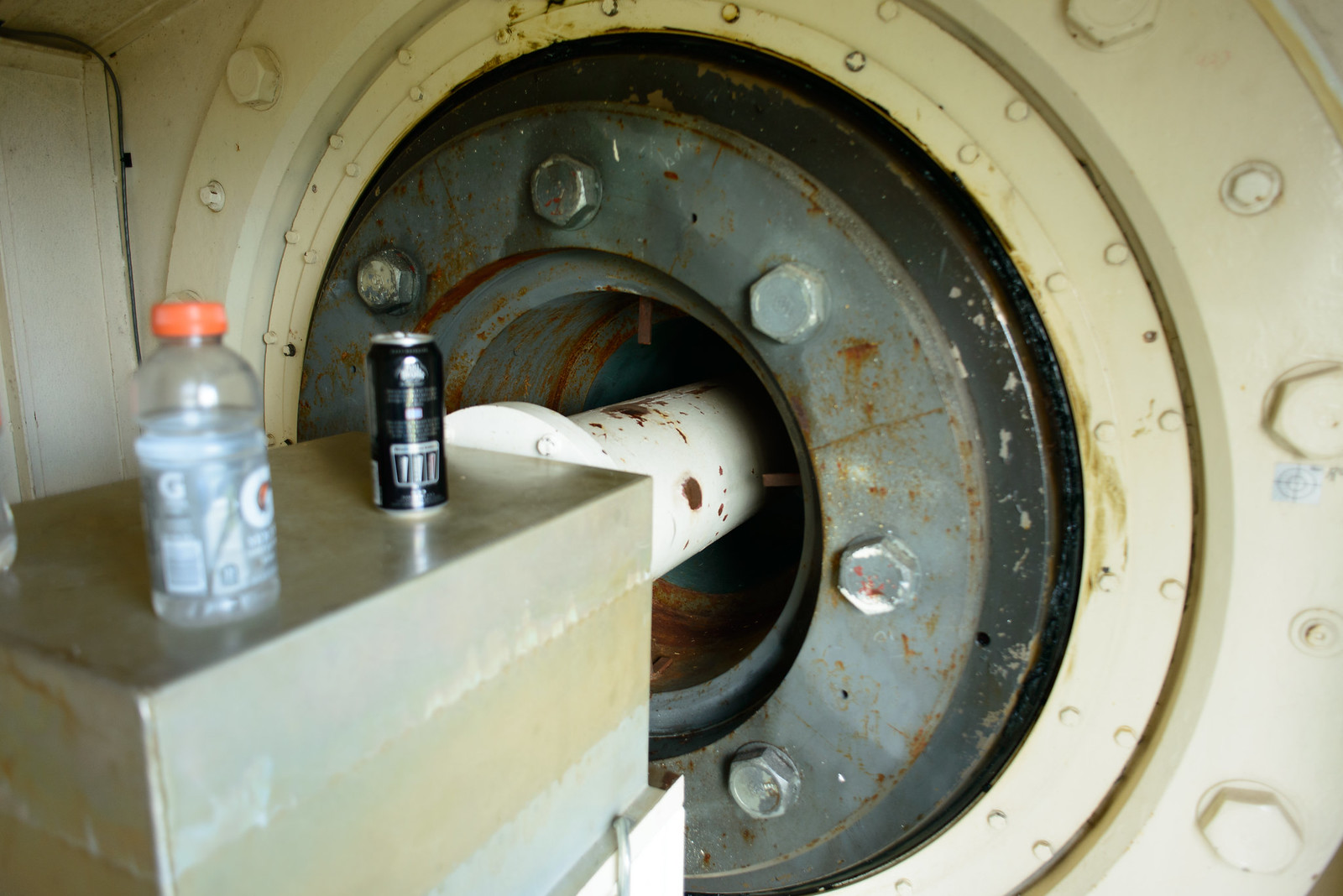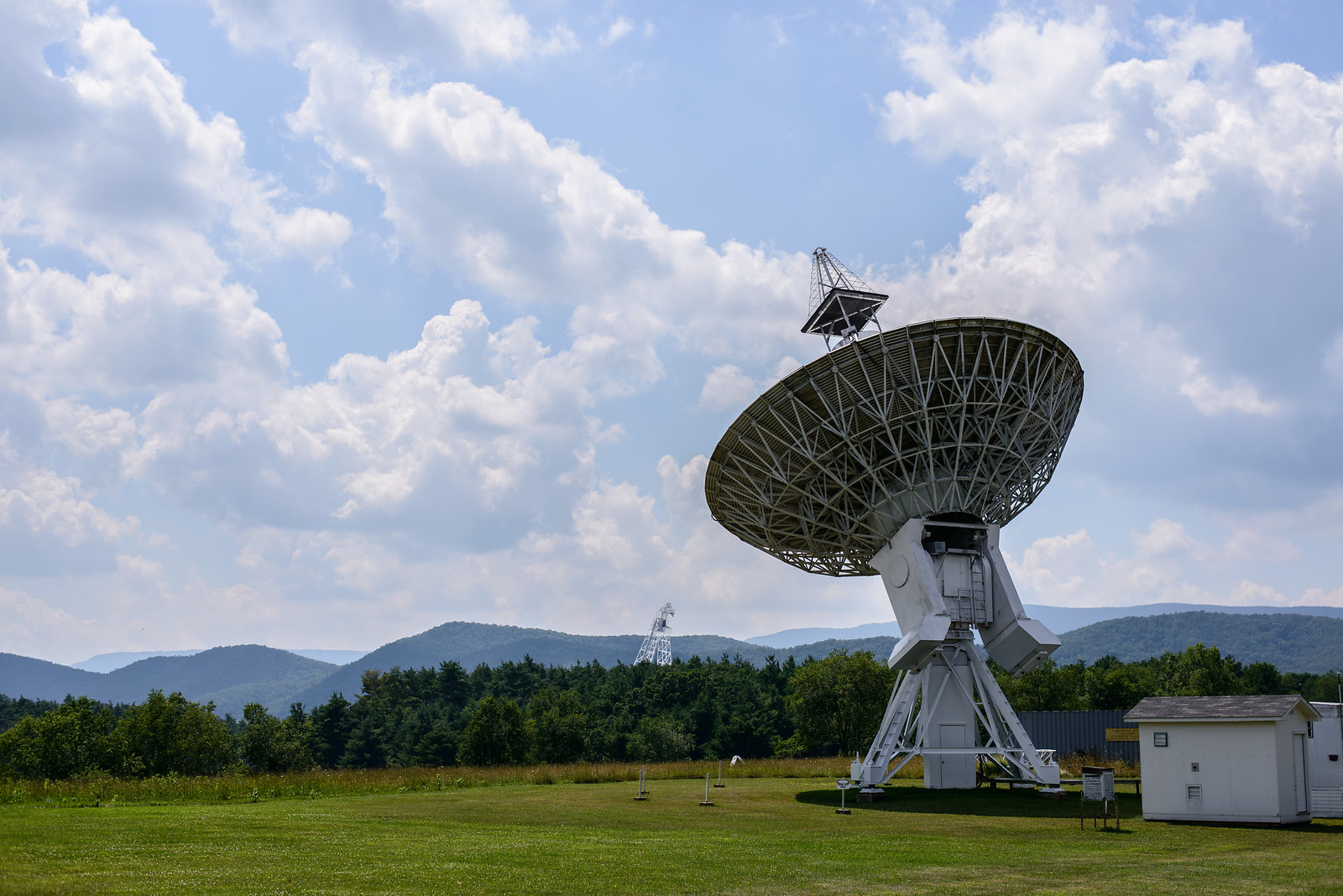For the season finale of Motherboard’s Spaced Out series, we paid a visit to West Virginia to check out the National Radio Astronomy Observatory’s incredible Green Bank Telescope. Thanks to the techno-wonders of DSLR cameras, I was able to shoot some photos while we wandered around the NRAO’s grounds, and thought I’d share a little tour with you of things that didn’t make the video cut. But seriously, go watch the video.The Green Bank Telescope is 485 feet tall and weighs something like 16 million pounds. It’s enormous, and dominates the landscape around the NRAO site in Green Bank. Green Bank is very rural, partly because it’s in the middle of the National Radio Quiet Zone, and the NRAO site still has remnants of old farms that were around before the NRAO formed in the late 50s. Nonetheless, the NRAO site is still a government research facility, although everyone there is extremely friendly to visitors. However, because of the telescopes’ sensitivity to electromagnetic radiation, cell phones have to be shut off at the site. (You won’t get service anyway.)
Nonetheless, the NRAO site is still a government research facility, although everyone there is extremely friendly to visitors. However, because of the telescopes’ sensitivity to electromagnetic radiation, cell phones have to be shut off at the site. (You won’t get service anyway.) The GBT is so sensitive that gas powered cars can’t get within a mile or two of the telescope because of the EM emissions from spark plugs. Diesel engines, which don’t use spark plugs to ignite combustion, are all gravy.
The GBT is so sensitive that gas powered cars can’t get within a mile or two of the telescope because of the EM emissions from spark plugs. Diesel engines, which don’t use spark plugs to ignite combustion, are all gravy. On the way to the GBT, you pass by a number of smaller scopes from throughout the NRAO’s history, some of which are still in service. I believe this is the 20 meter telescope that was used by the US Naval Observatory in the 90s, and which has since been retired.
On the way to the GBT, you pass by a number of smaller scopes from throughout the NRAO’s history, some of which are still in service. I believe this is the 20 meter telescope that was used by the US Naval Observatory in the 90s, and which has since been retired. But here is the main attraction. Holy cow, it’s impossible to describe how big the GBT is. I’ve never shot photos of anything so large, and it’s surprisingly difficult to try to capture its imposing bulk. It’s even taller than some of the low-lying hills surrounding it.
But here is the main attraction. Holy cow, it’s impossible to describe how big the GBT is. I’ve never shot photos of anything so large, and it’s surprisingly difficult to try to capture its imposing bulk. It’s even taller than some of the low-lying hills surrounding it. What’s even wilder is that the entire thing can spin on its base, and the dish tilts through an enormous range. (Here are a couple simple graphics explaining the movement.) In the winter, it can even tilt far enough to let snow slide off the dish. When we were visiting, the dish was flat, so we weren’t able to climb to the top of the reflector (that spire to the left).
What’s even wilder is that the entire thing can spin on its base, and the dish tilts through an enormous range. (Here are a couple simple graphics explaining the movement.) In the winter, it can even tilt far enough to let snow slide off the dish. When we were visiting, the dish was flat, so we weren’t able to climb to the top of the reflector (that spire to the left). We did, however, get to climb right up under the dish, which was still something like ten stories up. It’s amazing to see telescopes popping up in a region that has just about zero other tall buildings.
We did, however, get to climb right up under the dish, which was still something like ten stories up. It’s amazing to see telescopes popping up in a region that has just about zero other tall buildings. Those mountain ranges provide natural defenses against EM transmissions for the NRAO’s work. Much of the NRAO site is untouched, and deer and even apparently bears roam around the woods.
Those mountain ranges provide natural defenses against EM transmissions for the NRAO’s work. Much of the NRAO site is untouched, and deer and even apparently bears roam around the woods. The middle of this picture shows (barely) the research labs way off in the distance, and the cut through the forest allows staff to check on the orientation of the GBT. You can just see the barn in the first picture if you look closely. The GBT is huge.
The middle of this picture shows (barely) the research labs way off in the distance, and the cut through the forest allows staff to check on the orientation of the GBT. You can just see the barn in the first picture if you look closely. The GBT is huge. During the summer, crews rush to do maintenance work on the telescope. For as long as the weather’s good, people are climbing all over parts of the GBT to check the structure and paint as much as possible with a fancy reflective paint. It takes multiple seasons to paint the entire thing by hand, and thus the painting never stops.
During the summer, crews rush to do maintenance work on the telescope. For as long as the weather’s good, people are climbing all over parts of the GBT to check the structure and paint as much as possible with a fancy reflective paint. It takes multiple seasons to paint the entire thing by hand, and thus the painting never stops. There was a guy dangling in a rope-mounted basket about thirty feet below the deck we were standing on, just painting away. The painters are totally nuts, and like everyone else I met at the site, really friendly to chat with.
There was a guy dangling in a rope-mounted basket about thirty feet below the deck we were standing on, just painting away. The painters are totally nuts, and like everyone else I met at the site, really friendly to chat with. This walkway leads to an elevator that goes diagonally (!) up to the reflector. The walkway was tilted up at a crazy angle because of the orientation of the dish. I did see a few engineers did go up with climbing tackle, but we didn’t get to join.
This walkway leads to an elevator that goes diagonally (!) up to the reflector. The walkway was tilted up at a crazy angle because of the orientation of the dish. I did see a few engineers did go up with climbing tackle, but we didn’t get to join. Here’s another walkway that wraps around the motors for the telescope’s axis. Again, it was inaccessible.
Here’s another walkway that wraps around the motors for the telescope’s axis. Again, it was inaccessible. This is part of the shaft assembly for the telescope’s tilting mechanism.
This is part of the shaft assembly for the telescope’s tilting mechanism. Wires and conduits were running everywhere, I couldn’t help but think of Akira. After this, we rode back down to the ground in a tiny gear-drive construction elevator. I don’t have any pictures, but just imagine five people in hardhats with a bunch of camera gear being shoved into a coat closet.
Wires and conduits were running everywhere, I couldn’t help but think of Akira. After this, we rode back down to the ground in a tiny gear-drive construction elevator. I don’t have any pictures, but just imagine five people in hardhats with a bunch of camera gear being shoved into a coat closet. This is the NRAO’s 43 meter telescope, which I think is the coolest looking of the bunch.
This is the NRAO’s 43 meter telescope, which I think is the coolest looking of the bunch. I may be mistaken, but I believe that our guide Mike Holstine said that this scope was designed by someone who also designs big ships.
I may be mistaken, but I believe that our guide Mike Holstine said that this scope was designed by someone who also designs big ships. While not quite as mindblowing as the telescopes, this setup is rather important: It’s one of the stations for the NRAO’s EM emissions monitoring system. To keep the NRQZ radio quiet, stations like this one are scattered about to track and position any unwanted EM emissions that could corrupt the telescope data. One example that Holstine gave me was an improperly-wired electric fence for livestock, which was found and located through the NRAO’s monitoring system. When issues like that arise, the NRAO has staff to send out to help locals fix noncompliant electrical systems, and generally pays for any work or retrofitting that needs to be done.
While not quite as mindblowing as the telescopes, this setup is rather important: It’s one of the stations for the NRAO’s EM emissions monitoring system. To keep the NRQZ radio quiet, stations like this one are scattered about to track and position any unwanted EM emissions that could corrupt the telescope data. One example that Holstine gave me was an improperly-wired electric fence for livestock, which was found and located through the NRAO’s monitoring system. When issues like that arise, the NRAO has staff to send out to help locals fix noncompliant electrical systems, and generally pays for any work or retrofitting that needs to be done. I believe this is the NRAO’s 45 foot telescope, which is being used to record solar data.
I believe this is the NRAO’s 45 foot telescope, which is being used to record solar data. And I’ll close with the shot up top of the 20 meter scope. I have to say, the NRAO is rather amazing, not only for the data it collects and the research produced from that data, but also because it’s just so surreal to see a countryside filled with a bunch of telescopes peering at the sky. The facility’s funding is currently threatened, but here’s to hoping that the NRAO’s doors stay open for some time to come.Follow Derek Mead on Twitter: @derektmead.
And I’ll close with the shot up top of the 20 meter scope. I have to say, the NRAO is rather amazing, not only for the data it collects and the research produced from that data, but also because it’s just so surreal to see a countryside filled with a bunch of telescopes peering at the sky. The facility’s funding is currently threatened, but here’s to hoping that the NRAO’s doors stay open for some time to come.Follow Derek Mead on Twitter: @derektmead.
Advertisement
All photos can be enlarged with a click. Please credit this post if you use them.




Advertisement






Advertisement







Advertisement

